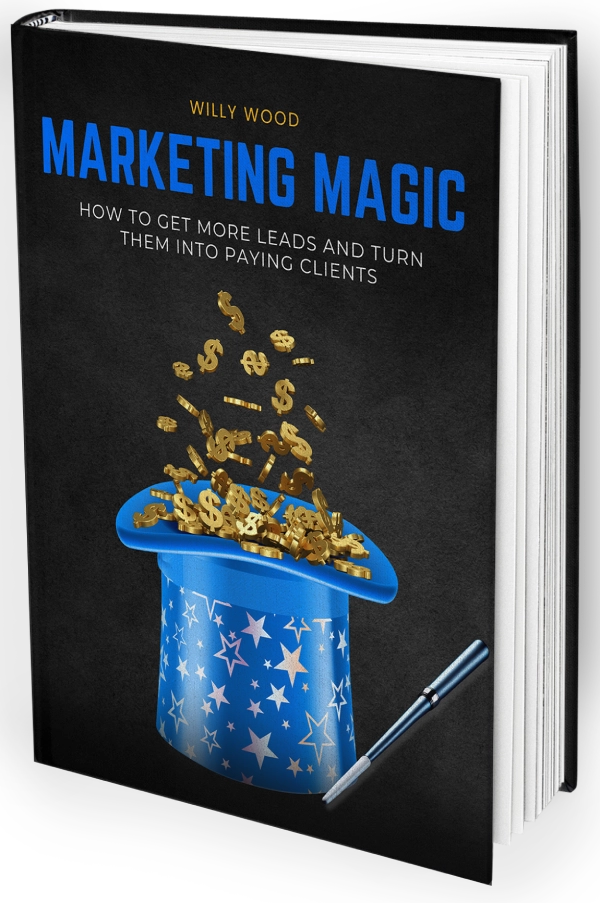You did it! You just published a featured guest blog post on a major blog in your niche…
Or you were just interviewed on a podcast followed by thousands of people you’d love to turn into clients for your business…
Of you slaved over an e-book or full-length traditionally published book for months, figuratively (and, I don’t know, maybe even literally) shedding blood, sweat, and tears to get every detail just right.
So now you’re a proud author (yes, I’m counting being interviewed on the podcast as “publication,” too—it’s content, from you, being put out into the world—that sounds like publication to me), and being a proud author is kind of like being a proud parent.
Whatever you just published—blog post, article, interview, book, whatever—started out as just a little embryo of an idea and now it’s all grown up and out there in the world, carrying your name to the masses.
So you should be proud. If nobody else is doing it, pat yourself on the back.
But that publication shouldn’t be the end of the process. Not by a long shot.
Becoming a published author is one of the fastest ways to boost your credibility and authority in your niche, but it doesn’t necessarily help your business grow all on its own without a little marketing help from you.
Of course, your content itself is the most important factor in establishing your authority, but beyond the main piece of content, there are many other things you can do to use your status as an author to boost your business success.
Today I want to focus on one seemingly small step, one that’s often overlooked by authors: maximizing the impact of your author bio.
What Is an Author Bio and Why Is It So Important?
First of all, some of you may be wondering just what an author bio is.
It’s that short paragraph (usually 2-3 sentences) that tells readers a little bit about you and how to get in touch with you or learn more about you that, for most online content (for example, guest blog posts), is usually found at the end of the article, though sometimes it’s in the site’s sidebar.
You can also have an author bio on your Amazon book pages for each book you write, and there are many other places where you can use a well-written author bio to boost your business’s visibility—for example, in the written intro to the podcast episode in which you were interviewed.
So, why am I writing an entire blog post to talk about how to write two or three sentences? Well, because it really is (or at least can be) an important piece of your overall marketing strategy for your business, so you don’t want to just dash something off.
You want to think about this and do it right because a well-written author bio can achieve the following strategic objectives:
- Give the reader the basic facts about your business
- Build your credibility
- Build rapport with your ideal clients
- Create a likeable character your clients will be attracted to
- Drive traffic to your website or social media channels where you can convince them to opt-in to your list or convert them to buyers or followers
That’s a pretty impressive list of accomplishments for just 2-3 sentences of writing!
So, to ensure that you make the most of those few sentences, let’s look at a list of 10 “to-do’s” for writing an effective author bio.
10 Tips for Writing the Perfect Author Bio
Tip #1: Don’t Skip the Basics: Say who you are, what you do, and who you do it for. Don’t leave out any of these three pieces of information, as they are all vital. Be as specific as you can for each of the three pieces.
For example, don’t say, “Cory Copywriter does copywriting for businesses.” Instead, say, “Cory Copywriter writes white papers and case studies for small to medium-sized non-profits.”
If that’s really what you do and you write the generic bio, people in other businesses who click through to find out more about you will discover that your work really isn’t for them and they’ll feel bamboozled.
If you write the more specific sentence above, only people who work for non-profits will click through (a much more targeted audience). And if they’re in the market for a white paper or case study, they’re your ideal customer and they’ve just found you. Score!
Tip #2: Keep it Short. The sweet spot for an author bio is 75-100 words. You can do everything I recommend here in 75-100 words or less. Most blogs and other sites where you will be using your author bio will give you a maximum word count, and it will usually be in this range.
Even if they allow you to write something longer, for the love of everything holy, don’t go over 150 words (your About page on your website or your Amazon author page is the place to give the more expanded bio). For one thing, going on too long will probably lead to you putting in a lot of detail that’s irrelevant to the audience reading your piece…
Which means you’ll bore them…
Which means they won’t click through to find out more about you. Opportunity lost.
Tip #3: Build Credibility, But Don’t go Overboard. A few, well-chosen titles or accomplishments can go a long way to establishing your credibility, so you need to include those.
The key is to only list the details that will be impressive to the audience reading your piece.
Maybe you’re the author of a book on leadership for school superintendents and principals who, in his spare time, is also an accomplished wind surfer.
If you write a piece in an education blog, list that you’re the author of the book. The school leaders reading your piece will be impressed. But don’t list your wind surfing accomplishments, unless you’re doing it to show something about your personality that somehow matches the content or tone of the piece (see Tips #5 and #7, below).
And vice-versa, if you publish a piece on a wind surfing blog, you probably won’t want to mention your leadership book. The wind surfers reading your piece are going to be all like, “Dude, who cares?”
Make sense?
Tip #4: Be Humble. Listing a few impressive accomplishments (Tip #3, above) lends authority, but a little humility also makes you likable. Try to find the balance.
This can sometimes be hard for people who are early in their careers and want to impress prospective clients. They have a tendency to pump up their accomplishments to try to make an impression. This often backfires, as readers see through the braggadocio and feel like they’re being scammed.
Oh, and be sure to write your author bio in the third person (“Connie Consultant,” not “I”)—that way, the accomplishments you do list won’t come across as so boastful because there’s a little distance there.
Tip #5: Say it With Personality. If you go out on the net and gather 100 author bios at random, 99 of them will sound the same.
Pompous. Wooden. Filled with jargon. Boring.
You don’t want that, do you?
Then be part of the 1% who write their bios with a little pizzazz. For example, I was reading a blog post on the 99 Designs website about business guru and author Tim Ferriss. Since this post was written collectively by the “99designs team,” it doesn’t have details about a single author, but check out how they describe their team in their collective author bio:
“The 99designs team is a rag-tag group of color-loving, creativity-celebrating, typography-appreciating, idea enthusiasts. Most of us like beer.”
Now, that’s personality. It may not be the kind of personality you’re attracted to, but if you are, then you’re likely to want to learn more about them. Show your personality in your bio and kindred spirits will flock to you.
Tip #6: Use a Photo with Some Personality. As with Tip #5, above, it’s important to show some personality, and one easy way to do that is to include a photo of you with your author bio, one that sets you apart from the 99% of stiffs out there with their oh-so-professional (read, “boring”) head shots. A few specifics:
- In your photo, smile. Even if you’re in a serious business sector, you don’t have to look like you’re suffering from kidney stones.
- Look at the camera. Make eye contact with the reader who’s going to see your author bio. It will help to draw him in. Save the staring-out-at-the-sun-rising-over-the-ocean shots for your family photo album.
- Dress in a way that says something about your personality. It doesn’t have to be in-your-face. If you like bright colors, wear something colorful. Don’t dress in a dark three-piece suit and tie because you think that’s what you’re “supposed” to do. Be you.
Tip #7: Speak to Your Intended Audience in Their Own Language. If you write for a number of different blogs, for example, do a little research about the people who read those blogs. Even if these blogs are all in the same niche, each audience is a little different.
Talk to the blog owner about her audience. Find out the key demographics. Ask about the kinds of material they seem to find most interesting and respond to the most.
Remember, you’re trying to attract new readers and new clients, not only with the main content pieces you write, but also with your author bio. So write you bio in such a way that it speaks to this audience specifically…which means, yes, you’ll need to tweak your author bio for every piece of content you write. You can’t just cut and paste it from the last job.
Deal with it. That’s part of being a professional.
Tip #8: To Generate Opt-ins, Include a Link to Your Lead Magnet Landing Page. If you’re trying to build your e-mail list, you can use your author bio to drive traffic to your free lead magnet landing page.
Make sure that the freebie you offer in your bio is relevant to the content piece so that people who like the piece and want “more of the same” can click over and get it.
This is a quick, easy, and powerful way to build your list. And if you have your e-mail program set up to segment these new opt-ins by the source from which they came, you already know something about them and can then make them future offers that are relevant to their interests.
Tip #9: To Generate Contacts or Sales, Link to a Primary Services Page or Offer.
Blogs are probably not going to allow you to link directly to a sales page from within the post itself and podcasts are probably not going to let you make a blatant sales pitch during your podcast interview because that will make them look spammy to their own followers, but they usually have no qualms about letting you link to a main services page or even a sales landing page from your author bio.
Again, this works best if the specific service page or offer you link to is related to the content piece they just consumed. If they like the piece enough to click over to get more content from you, they may very well become your next client or customer.
Tip #10: To Generate Social Followers, Include a Social Link.
If you use social media to help promote your personal brand and/or your business, don’t miss the chance to drive traffic from your author bio to your main social channel by including a link to it.
Every reader is different. Some may read your piece and want to purchase your product on your website. Others may not want to buy anything, but they may fall in love with you through the piece they just consumed and want to follow you on social media. So give them the chance to do so. Social media followers often turn into buyers somewhere down the line.
By the way, do no more than two of the previous three steps. Don’t include a link to a lead magnet AND a link to a service page AND a link to your social media channel. It’s too much and comes across as a hard sell.
Author Bio Examples
Now that I’ve laid out for you some ground rules to follow, let’s take a look at some good author bio samples:
Here’s one I ran across on a blog post while researching for this post:
“Mish Slade is the founder of copywriting agency Mortified Cow – which takes a decidedly different view on how businesses should promote themselves. Her latest book is called May I Have Your Attention, Please? Your Guide to Business Writing That Charms, Captivates, and Converts.”
I like this author bio because it shows personality. First of all, how cool is her name? “Mish Slade”—sounds like a character in a noir film or something. Plus, the name of her agency, “Mortified Cow” just oozes personality. I have no idea how “mortified cow” relates to copywriting, but I’m intrigued enough to click over to find out (which I did). You’ll also notice that the bio is short and that it offers links to her business website and to her current book offer.
Here’s another one I like:
“Houston Kraft is a speaker, curriculum developer, and kindness advocate who has spoken at over 600 schools or events internationally. In 2016, he co-founded CharacterStrong—curriculum and trainings that transform the way schools teach social-emotional learning, character education, and Kindness. To date, they have worked with over 2,500 schools globally serving over 1 million students. In 2019, his face was featured on Lay’s BBQ chip bags as someone who helps “spread smiles.” In 2020, his first book, Deep Kindness was released. His mom is his hero, and her best life lesson is to ‘hug like you mean it.’”
This one is a bit more traditional. It gives multiple credibility details (maybe a few too many?), it links to his business site, and it links to his book. But it also has some personality—face on a Lay’s chips bag? That’s not something you see every day. And the part about his mom being his hero is nice, too. But notice that the chips bag and the “mom’s my hero” details aren’t just random; they’re tied to his main theme of teaching Kindness.
And one more to wrap things up. This one is from an Amazon book page:
“Nick Stephenson’s books combine murder, mystery, and mayhem with a healthy dose of humor. The Leopold Blake books have consistently hit the top five Amazon paid bestseller lists in Crime Thriller Fiction, and can be read and enjoyed in any order. You can check out the entire series here: amazon.com/Nick-Stephenson/e/B004MYQ8K6 (just copy and paste into your browser).
Nick Stephenson was born and raised in Cambridgeshire, England. He is a fiction author and novelist, writing in the mysteries and thrillers genre. His approach to writing is to hit hard, hit fast, and leave as few spelling errors as possible. He writes mysteries, thrillers, and suspense novels, as well as the occasional witty postcard, all of which are designed to get your pulse pounding. Don’t let his headshot fool you—he’s actually full colour, on most days.
In a previous life, Nick Stephenson has worked as a lawyer, marketer, chef, and paid assassin for the UK’s Tax Authorities. If you ask him about it, he will deny ever having worked as a lawyer. To get an email whenever the author releases a new title, sign up for the VIP newsletter at nickstephensonbooks.com (just copy and paste into your browser).”
This one obviously violates the 75-100 words rule (it weighs in at a hefty 198). But you can see that it has a lot of strengths, too. It establishes credibility (“consistently hit the top five Amazon bestseller lists”). It tells you who he is, what he does, and who he does it for. He gives you the chance to go to his Amazon page for his Leopold Blake series (so you can buy multiple books at once) and gives you the chance to go to his website to sign up for his newsletter (his lead magnet) so he can get you on his mailing list. And, of course, he shows a great sense of humor that he lists as a trademark of his work—so if you like his author bio, he implies, you’ll like his books, too. Really well done.
I hope you’ve picked up a few ideas for how to make your author bio work for you. Let me know what questions or comments you have in the box below.






